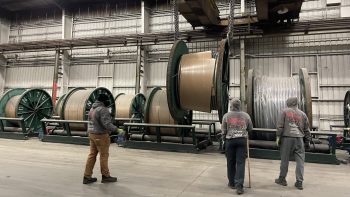
With the Port of Baltimore accessible again, longshoremen return to work
With the Port of Baltimore accessible again, longshoremen return to work

Work is ramping up again at the Port of Baltimore. The U. S. Army Corps of Engineers announced last week that 50,000 tons of wreckage have been removed after the collapse of the Francis Scott Key Bridge and that the main waterway to the port is now fully restored.
That means cargo ships are able to easily come and go, and there is more to do for the nearly 3,000 longshoremen who work in the port. These are the people who tie ships to the shore, unload containers and vehicles and keep track of everything that’s unloaded.
One of those longshoreman is Jim Pumphrey. Deep in the belly of the Victoria Highway, he picked up a length of heavy chain. Each one can hold 10 tons.
“They lash down into here,” he said, indicating the floor of the ship, “and they go up into a piece of equipment.”
That includes construction equipment, mining vehicles and regular old cars — goods known as “roro” because they roll on and off the ship. The chains hold the vehicles in place until they’re ready to be driven off.
Pumphrey is 66 and this is pretty physical work, he said. There are lots of moving parts, so he, and everyone else, wore bright, neon safety clothing. His shirt was yellow. He waved at another longshoreman in a hot pink safety vest who was driving a massive truck used for mining down the ship’s ramp and on to shore.
“That’s Sharon. Yeah, she’s a driver. She’ll drive anything. She drives better than most men,” said Pumphrey.

Sharon Ridgeway is one of hundreds of female longshoremen who work at the port in a job traditionally done by men. Down in the parking lot, she said she doesn’t call herself a longshorewoman.
“I stick with ‘longshoreman.’ Been here too long,” she laughed.
Ridgeway, who’s 63, has been here 14 years. When she started, she had teenagers at home and wanted something flexible. She can pick up shifts when she wants to, and she said her co-workers are her favorite part of the job.
“We can all tease each other and carry on, but we get the job done,” said Ridgeway.
Ridgeway said her colleagues are like family, and like a lot of the other longshoremen, members of her real family worked here first. Cousins as well as her husband.
Meanwhile, 30-year-old Tyler Tippett followed his dad here. Tippett’s a line handler. He stood at the end of a pier pulling in lines, which are basically giant ropes that have been thrown out by the crew of the Höegh Berlin, another ship that’s docking.
Tippett didn’t always want to do this. He took a summer job here after a year of college and said the money made him decide to leave school.
“Most of my friends were working minimum-wage jobs and putting themselves in debt. And I felt like I was already a couple years ahead of them with the amount of money I was making,” said Tippett.
Like most Baltimore longshoremen, Tippett’s in a union that guarantees starting pay of $20 an hour. The union said that goes up with time, reaching the top rate of $39 an hour after six years on the job. There’s also health benefits, a 401(k) and a pension. They get overtime on nights, early mornings, weekends and holidays.
Another line handler, Dave Couslin, said working when others are not isn’t uncommon.
“We work all holidays. Because the ships come in on the holidays for the next day to work,” said Couslin. “So we’re here tying them up.”
Couslin said he’ll sleep in his car between ships coming in. He also said the work comes with risks. The pier can get icy, and he has to be careful not to fall in the water. He’s been doing this for more than 10 years.
“We make real good money,” said Couslin. “And most of us aren’t college-educated. We’re just commonsense guys, and we make just as much as an accountant. Not a real big accountant. But you know what I mean. We make as much as a shirt-and-tie guy, probably more. It’s worth coming in to work.”
Couslin wouldn’t say exactly how much he takes home in a year. But the union said longshoremen can make six figures annually.
Couslin said he’s going to retire next year. He’s 69. Despite the risk and discomfort, he has enjoyed being on the water all the time.
It’s also a job where he can see the results of what he’s done. There’s immediate and tangible satisfaction in helping a ship dock and making sure that what’s on it gets where it’s supposed to go.
There’s a lot happening in the world. Through it all, Marketplace is here for you.
You rely on Marketplace to break down the world’s events and tell you how it affects you in a fact-based, approachable way. We rely on your financial support to keep making that possible.
Your donation today powers the independent journalism that you rely on. For just $5/month, you can help sustain Marketplace so we can keep reporting on the things that matter to you.


















